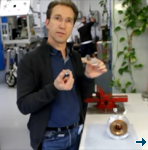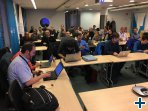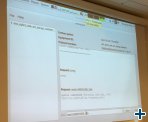Related News
40 participants met in Lund to discuss the SINE2020 Sample Environment collaboration
The SINE2020 work-package on Sample Environment met on January 25-26 in Lund to present and discuss updates on the WP tasks.
15/02/2017
Contact: Eddy Lelièvre-Berna
Partners: ILL, ESS, STFC, PSI, TUM, CEA, HZB, HZG, CSIC, NPI
The SINE2020 work-package on Sample Environment aims to improve the environment surrounding samples both on neutron and muon experiments, thus improving data statistics and opening new fields of science. Thanks to close collaboration fostered by SINE2020, each member’s developments will be useful for the other facilities. A total of 40 WP members (scientists, engineers and technicians) met on January 25-26 in Lund to present and discuss updates on the WP tasks.
Below we list the main topics discussed.

Participants visiting the ESS construction site during the SINE2020 Sample Environment meeting. © Eddy Lelièvre-Berna, ILL.
Task 7.1: FLOSS software standards for sample environment
The first task is to develop standards to facilitate the communication between the instrument control work station and the sample environment equipment across facilities. Presentations addressed:
- The very first demonstration of the SECoP protocol.
- Next steps: conduct tests and prepare libraries for C/C++ and Python.
Task 7.2: towards efficient sample environment for neutron research
Task 2 is to work towards an efficient sample environment for neutron research.
7.2.1: Signal to background ratio improvements
One of the approaches is to improve the signal-to-background ratio in the detectors. Presentations addressed:
- Preliminary benchmarks performed with data collected from calorimeters at ILL.
- Technique allowing the overlap of different geometries, each producing different scattering contributions => multiple scattering.
- Simulations of the future BEER instrument that will be built at ESS. These simulations combine several contributions, e.g. sample + container + cryostat.
-> Teams from different facilities agreed on collaborating to implement the code in McStas.
7.2.2a: Non-magnetic goniometer for dilution refrigerators
The second approach is to improve experiments by providing tools to facilitate them and reduce beam-time losses (7.2.2a and 7.2.2b). Presentations addressed:
- Production of parts insulating the goniometer from the dilution mixing chamber.
- The survey has shown that it will be difficult to adopt a common design at all facilities. Possible solutions were discussed and compromises agreed on.
7.2.2b: Fast cooling furnace
- Huge gain factor obtained with a 2 L/min He flow.
- The body temperature rises to about 100°C during fast cooling operation which is acceptable. No issue was encountered over the past year using a modified vanadium furnace. We can conclude that the fast cooling technique does not reduce sensibly the lifetime of the heating elements and heat shields.
Task 7.3: next generation pressure cells for neutron and muon research
Task three is to build new generation of pressure cells from new materials and designed from novel geometries to boost the capabilities of neutron scattering and muon spectroscopy.
7.3.1: Improved muon spectroscopy piston cell
The first step is to improve the piston cell for muon instruments. Presentations addressed:
- Design of a double-layer cell made from CuBe and MP35N. Material characterization was performed to supply ANSYS with realistic data. The optimum diameters have been determined using ANSYS coded to refine solutions.
- Prototypes fully made from CuBe and CuBe/MP35N have been built and tested successfully thanks to the help provided by high-pressure experts participating in the collaboration.
7.3.2.a Anvil pressure cells for μSR
Is it possible to use anvil pressure cells on µSR instruments? Any other pressure cell at ISIS?
- After some brainstorming and some investigations, it looks non-realistic to develop anvil pressure cells for µSR.
- Report on the μSR tests performed with dummy cells to determine if they could exploit the PSI cell design at ISIS. Further tests with higher density samples are scheduled for February.
7.3.2b: Novel anvils for Paris-Edinburgh cells
We would like to replace the anvils and the pressure-transmitting media by materials transparent to neutrons. One idea is to improve the vertical angular access to samples compressed in Paris-Edinburgh cells. Presentations addressed:
- Report on experiments: background contributions of the pressure transmitting media, the gaskets, the neighbouring instruments, etc. have been determined on D20 at ILL. Discussions identified ways to reduce some of these contributions.
7.3.3: Novel non-magnetic, neutron, clamp cell
Looking at clamp cells, the plan is to investigate whether we can have several layers of different materials to improve the cell’s transparency and decrease the diffuse scattering of the cell. Presentations addressed:
- Transmission and background data were collected on IMAT (neutron imaging), LET (cold-neutron multi-chopper spectrometer) and WISH (long-wavelength diffractometer) of dummy cells made from Al 7049, Al 7075, CuBe, MP35N, TAV6, NiCrAl and TiZr.
-> The collected data will be used to calculate multilayer hybrid cells and by the 7.2.1 team to check the new McStas component.
7.3.4: 700 bar H2 container for studying storage equipment
Neutrons are ideally suited for investigating hydrogen storage directly and our aim is to provide equipment matching industry requests. Presentations addressed:
- Design of the setup and the safety issues discussed with several neutron facilities.
- The drawings are complete and a prototype should be ready in June.
Task 7.4: Complementary in-situ measurements for neutron and muon experiments
In task 4 there are two different projects which aim to make complementary measurements on the beam, one for neutrons and another one for muons.
7.4.1: In-situ muonium studies
For muon research the aim is to build a cavity with a RF field that enables to explore mechanisms in chemistry and chemical physics. Presentations addressed:
- Kits being redesigned with the aim to provide a wider range of experimental conditions.
- A prototype birdcage RF coil is being prepared and on-beam commissioning is scheduled in March to check the sample stability.
7.4.2: In-situ NMR setup
The aim here is to build a compact low-field NMR system sitting on a neutron beam that will allow the simultaneous measurement of diffusion coefficients not accessible with neutrons. Presentations addressed:
- Preparation of the NMR setup for a beam test planned on the tomograph station of the LLB. The goal with this NMR setup is to measure diffusion coefficients rather than shift.




